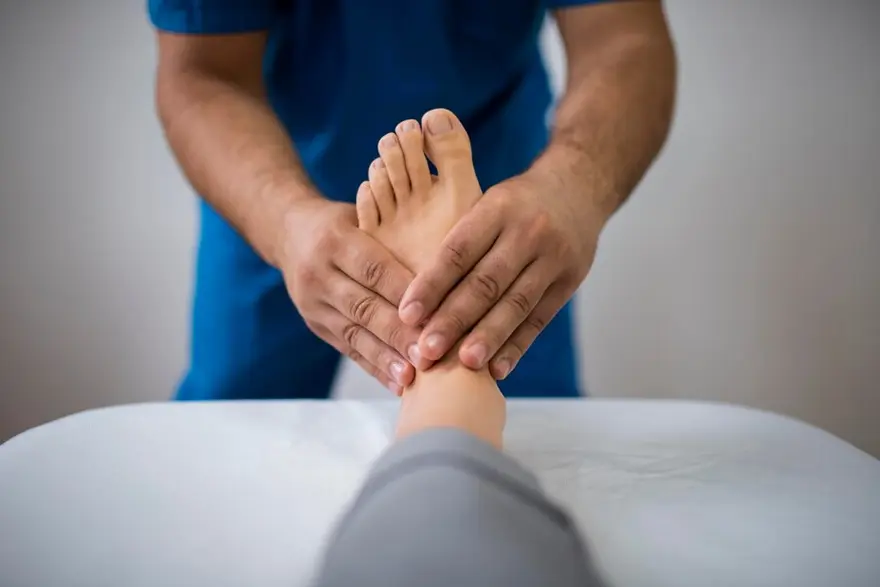Preventive Healthcare
Understanding Plantar Fasciitis: Causes, Symptoms, and Treatments
1358 Views
0

What is Plantar Fasciitis?
Plantar fasciitis is a form of inflammation of your foot, specifically the plantar fascia region. The plantar fascia is like a fibrous ligament that goes from the balls of your foot up to your toes. It is similar to a thick, stretchy rubber band and is used to connect the bones of your foot and form the arch at the bottom of your foot.
Plantar fasciitis is when your plantar fascia is stretched too far or overused. You may often feel pain in one foot at a time; however, plantar fasciitis may simultaneously affect both your feet in more severe cases.
How Common is Plantar Fasciitis?
Plantar fasciitis is a fairly common condition, with over 2 million people per year around the world. Experts believe 1 in 10 people will eventually develop plantar fasciitis, most common among people between 40 and 60.
What are the Primary Symptoms of Plantar Fasciitis?
Plantar fasciitis symptoms include:
- Pain in the heel and arch of the foot
- Stiffness of the foot
- Tight Achilles tendon
- Swelling around the heel
What Does Plantar Fasciitis Feel Like?
Plantar fasciitis usually causes an achy pain at the bottom of your foot or the heel. This pain can change depending on the time of the day and what you are doing. It can feel like
- A constant dull ache
- Pain that occurs when you stand after sleeping or sitting down but goes away after a few minutes of walking
- Stabbing sharp pain when you use the affected foot or put pressure on the heel
- Moving and exercising helps reduce the pain, but it can start as soon as you stop moving.
What are the Leading Causes of Plantar Fasciitis?
Doctors used to believe that heel spurs caused pain in individuals with plantar fasciitis. But this view was changed eventually. Today, one of the leading causes of plantar fasciitis is the overuse or overstretching of the ligament. Small tears or a single tear can also cause pain. The structure of your foot can also be one of the plantar fasciitis causes.
What are the Risk Factors for Plantar Fasciitis?
Some of the risk factors for plantar fasciitis include
- playing sports or long-distance running
- working on your feet all day
- walking or exercising on hard surfaces
- wearing shoes that do not have enough support
- exercising without warming up
- standing or walking barefoot at home
- a tight Achilles tendon
Health conditions such as high-arch feet, flat feet, and obesity can also be some of the plantar fasciitis causes or risk factors.
How is Plantar Fasciitis Diagnosed?
A physical examination is usually needed for plantar fasciitis diagnosis. Your doctor will examine your foot and check for inflammation and pain levels. Inform your doctor about any pain you may be experiencing during your daily routine, where your foot hurts, and the most painful time.
What Tests Do Healthcare Providers Use to Diagnose Plantar Fasciitis?
Your doctor may order the following imaging tests to confirm a plantar fasciitis diagnosis:
- X-rays
- Ultrasound
- MRIs
How is Plantar Fasciitis Treated?
Your doctor may advise a lot of rest and over-the-counter medicine for your plantar fasciitis treatment. They may even suggest ways to better support your foot to reduce pain and the possibility of experiencing plantar fasciitis.
Nonsurgical treatment for Plantar Fasciitis
If you have been experiencing heel and foot pain for over a week, you may have to visit your doctor for plantar fasciitis treatments.
Physical therapy
Physical therapy is one of the main plantar fasciitis treatments; it aids in stretching the plantar fascia and your Achilles tendons. A physiotherapist will demonstrate exercises to help strengthen your leg muscles and stabilize your walk to lessen the load on your plantar fascia.
Shock wave therapy
If physical therapy does not work, your doctor may suggest other plantar fasciitis treatments, like using sound waves to bombard your heel to help promote healing in the ligament. Extracorporeal shock wave therapy has been very effective in relieving plantar fasciitis pain and is considered the best option after surgery.
Stretching exercises
Gentle stretching of your foot can help relieve plantar fasciitis pain and even prevent it in most cases. Stretching your calves and plantar fascia can help loosen the muscles and reduce pain. You may also have to take a break from strenuous exercises like running to give your body time to heal. Always remember to stretch before any exercise.
Surgical Treatment for Plantar Fasciitis
Surgery is the last case scenario for plantar fasciitis treatment and is only done if the pain lasts for over 6 to 12 months after starting treatment.
Gastrocnemius recession
This medical treatment for plantar fasciitis is recommended when you have trouble flexing your feet, even after stretching consistently. Here, the calf muscles are lengthened to help increase ankle motion and flexibility in your foot.
Plantar fascia release
In this type of plantar fasciitis treatment, the surgeon cuts a small part of your plantar fascia ligament and releases some tension, which in turn aids in relieving inflammation. It can include minor cuts to the ligament or detaching it entirely from the heel bone.
What are the Most Effective Home Remedies for Plantar Fasciitis?
While home remedies for plantar fasciitis help relieve pain and inflammation, they do not address the damage to your ligament.
Home treatments for plantar fasciitis
The first step is to get off your feet and apply ice on the affected area for 15 to 20 minutes, 3 to 4 times a day. You can also change or reduce your exercise and use more supportive shoes when exercising. Nonsteroidal anti-inflammatory drugs also help soothe this pain.
Braces and supports for plantar fasciitis.
Night splints are a form of brace that keeps your foot flexed. This lengthens the plantar fascia and Achilles tendon overnight, which helps prevent pain and stiffness in the morning.
Orthotic shoes or arch supports help distribute the pressure on your foot, thus preventing further damage to your plantar fascia.
Essential oils for plantar fasciitis
Few studies show that essential oils like lavender, rose, eucalyptus, and lemongrass can help reduce pain and inflammation caused by plantar fasciitis.
CBD oils for plantar fasciitis
Cannabidiol (CBD) is found in the cannabis plant; products with this compound can treat pain and inflammation.
Nutrition and supplements for plantar fasciitis
A balanced diet and taking supplements that help in tissue healing and repair can help reduce pain related to plantar fasciitis. These supplements include
- zinc
- vitamin C
- fish oil
- glucosamine
- bromelain
Eating a healthy diet helps you lose weight, which in turn helps relieve heel pain as there is less pressure on your foot.
How Long Does it Take to Recover From Plantar Fasciitis?
Mild to moderate plantar fasciitis symptoms can improve with a few months of home remedies. However, more severe cases may need medical treatments like surgery, which may have a slightly longer recovery time.
How Can You Prevent Plantar Fasciitis?
Changes in your lifestyle, like wearing more supportive shoes, losing weight, replacing athletic footwear regularly, and low-impact exercises like swimming or bicycling, help reduce the possibility of developing plantar fasciitis.
Are Plantar Fasciitis and Heel Spurs the Same Thing?
Plantar fasciitis and heel spurs are not the same thing. While plantar fasciitis is caused by overuse or long-term stress on your feet, a heel spur is a small hook of bone that forms over the heel bone. Heel spurs do not often show any symptoms.
Do Children Get Plantar Fasciitis?
Children can also develop plantar fasciitis when they wear old or unsupportive shoes. This condition can worsen over time, so you need to see a doctor immediately to diagnose and treat plantar fasciitis.
Icing your child's heel and massaging the area can also help reduce the pain and heal plantar fasciitis in children.
What are the Potential Complications of Plantar Fasciitis?
Ignoring plantar fasciitis symptoms can cause chronic pain. It also changes how you walk, leading to pain in your legs, knees, back, and hips. Steroid injections and other forms of treatment can cause the plantar fascia to weaken and potentially rupture.
The risk of plantar fasciitis surgery includes bleeding or infection. It could also lead to foot and nerve damage.
Conclusion
Plantar fasciitis is a fairly common condition that can be easily cured immediately. Ignoring symptoms or not taking care of your weight and lifestyle can cause chronic pain that would eventually need surgery and other complications. Keep track of your health with regular health checkups at diagnostic labs like Metropolis Healthcare and ensure you are safe from lifestyle diseases like plantar fasciitis.













1701259759.webp)









 WhatsApp
WhatsApp